Amyitis
Author: Cyril Demaegd
Publisher: Ystari Games / Hutter Trade
Year: 2007
review by

| x |
|
|
|
|
|
|
|
|
|
|
|
|
|
|
|
|
|
|
|
|
|
|
|
|
|
|
|
|
|
|
|
|
|
|
|
|
|
|
|
|
|
|
|
|
|
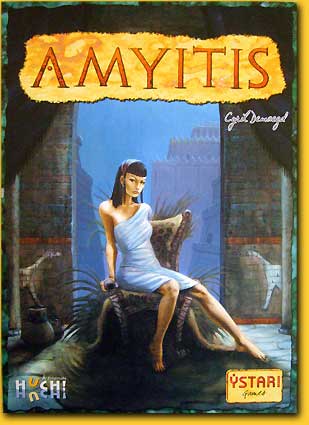 |
|
Amyitis, daughter of the King of the Medes, became Queen of Babylon in 590 before Christ. However, Babylon made her homesick for the green mountains in her home country, currently known as Northern Iran. Her husband, King Nebukadnezar, wanted to please his beautiful wife and decided to build her the famous hanging gardens of Babylon. And that’s where we come in! |
| x |
|
|
|
|
|
|
|
|
|
|
|
|
|
|
|
|
|
|
|
|
|
|
|
|
|
|
|
|
|
|
|
|
|
|
|
|
|
|
|
|
|
|
|
|
|
| The board shows a river, and a grid of 4x4 terraces where the gardens have to be planted. It is our job to irrigate and plant the terraces. |
| x |
|
|
|
|
|
|
|
|
|
|
|
|
|
|
|
|
|
|
|
|
|
|
|
|
|
|
|
|
|
|
|
|
|
|
|
|
|
|
|
|
|
|
|
|
|
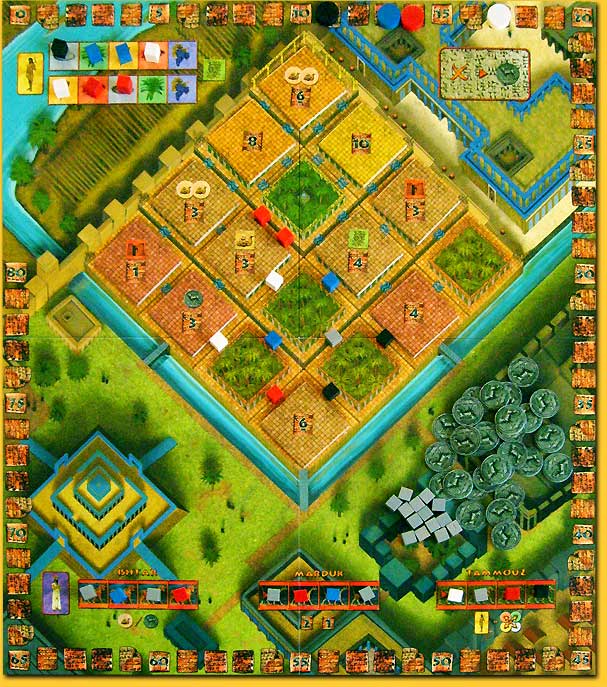 |
| x |
|
|
|
|
|
|
|
|
|
|
|
|
|
|
|
|
|
|
|
|
|
|
|
|
|
|
|
|
|
|
|
|
|
|
|
|
|
|
|
|
|
|
|
|
|
| There is a separate board where a camel caravan travels around, and all the locations the caravan visits are connected to a specific action. In our turn, we may perform one action, and we can choose between recruiting a character, moving the caravan or pass. |
|
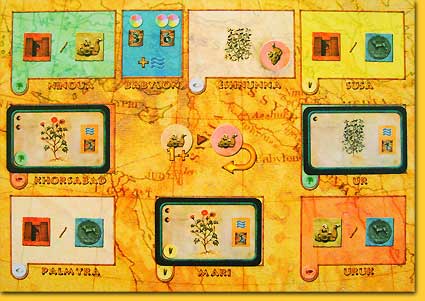 |
| x |
|
|
|
|
|
|
|
|
|
|
|
|
|
|
|
|
|
|
|
|
|
|
|
|
|
|
|
|
|
|
|
|
|
|
|
|
|
|
|
|
|
|
|
|
|
| There are four different characters, and every round they are lain out in groups of three, according to the number of players. The first character from a set of three can be used for free, the second character costs 1 talent, and the third character 2 talents. If you take a peasant, you may place a cube in your colour on one of the two rows of fields, and you may take the corresponding resource token from the general stock. A merchant allows you to take a camel token from the stock, and with an engineer you can build on the irrigation system. This means that you may place a cube of your colour on one of the water-symbols next to a terrace. A terrace is considered irrigated as soon as all the water symbols on at least one of the four sides of the terrace have been covered by cubes. Each cube immediately earns the owner 2 points. |
| x |
|
|
|
|
|
|
|
|
|
|
|
|
|
|
|
|
|
|
|
|
|
|
|
|
|
|
|
|
|
|
|
|
|
|
|
|
|
|
|
|
|
|
|
|
|
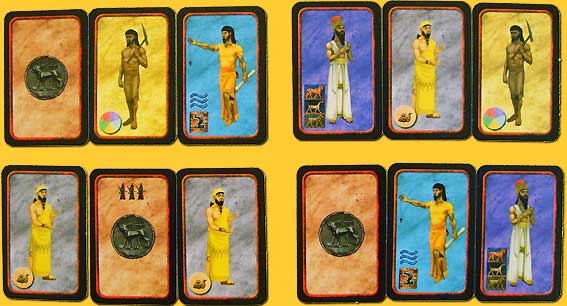 |
|
| x |
|
|
|
|
|
|
|
|
|
|
|
|
|
|
|
|
|
|
|
|
|
|
|
|
|
|
|
|
|
|
|
|
|
|
|
|
|
|
|
|
|
|
|
|
|
| The last card to mention is the priest: at the bottom of the board three temples are displayed where various advantages can be earned later in the game. When you select the priest, you may place one cube in one of the temples. If the temple was already full, the first-placed cube is removed from the temple and returned to its owner. |
| x |
|
|
|
|
|
|
|
|
|
|
|
|
|
|
|
|
|
|
|
|
|
|
|
|
|
|
|
|
|
|
|
|
|
|
|
|
|
|
|
|
|
|
|
|
|
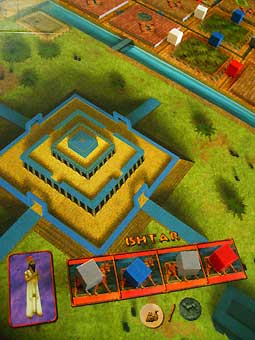 |
|
Moving the camel caravan costs one camel token per step; the action associated with the destination of the caravan must be carried out. The possible actions are:
- trade resource tokens for victory points
- pay the resource token displayed on the board and take a blue card, that brings you 1 talent/ 2 talents/ 2 talents and 2 points in the income phase
- pay the resource token displayed on the board and take a pink card, that immediately earns you 1-10 points
- pay the resource token displayed on the board and take a yellow card, which allows you to move the caravan 2 or 4 additional steps without paying any camel tokens
- pay the resource token(s) displayed on the board and plant one irrigated terrace. This means that you may remove a terrace card from the board, thus revealing the underlying palm trees, and collect the points or bonuses displayed on the card.
|
| x |
|
|
|
|
|
|
|
|
|
|
|
|
|
|
|
|
|
|
|
|
|
|
|
|
|
|
|
|
|
|
|
|
|
|
|
|
|
|
|
|
|
|
|
|
|
| But mind: there are cheap plants (1 resource token) and expensive plants (2 resource tokens), and the cheap ‘level 1’ plants can only be used for the lower terraces. For the second level terrace, you need a ‘level 2’ plant, and for the third and fourth level terraces you even need a ‘level 3’ plant. Luckily, there are green cards that can be used to upgrade the plants with one level per green card. Finally, there is an additional bonus of one or two points for the player that paid the major contribution to the irrigation of the terrace that has just been planted. |
|
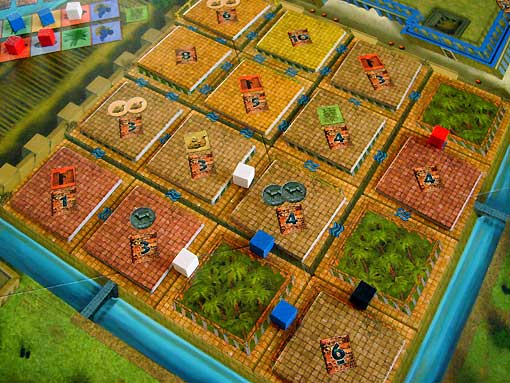 |
| x |
|
|
|
|
|
|
|
|
|
|
|
|
|
|
|
|
|
|
|
|
|
|
|
|
|
|
|
|
|
|
|
|
|
|
|
|
|
|
|
|
|
|
|
|
|
|
If you can’t or don’t want to do anything anymore, you have to pass. You place a cube in the pass-square, and every time that it’s your turn again, you may take one talent, until all other players have passed as well. Usually, when one player has passed, the others will not wait too long either, because they don’t want the others to keep cashing. This conveniently prevents that after passing, players start reaching for a newspaper, or start SMS-ing with friends and loved ones.
At the end of the round, the player to the left of the starting player is allowed to place a cube in one of the three temples, and a neutral, grey, cube in the other two temples. Then, prizes are awarded to the players that have the most and second-most cubes in the three temples.
The players are allowed to keep a maximum of two resource tokens for the next round; excess tokens have to be discarded. The next player becomes starting player, all players in possession of a blue card collect their income, and new character cards are drawn. The game continues until only 3 (2 players) or 4 (3 or 4 players) unplanted terraces remain. Players receive bonus points for the number of terrace cards they’ve collected, and all remaining resource tokens give one point. The player with the highest total wins the game.
|
| xx |
|
|
|
|
|
|
|
|
|
|
|
|
|
|
|
|
|
|
|
|
|
|
|
|
|
|
|
|
|
|
|
|
|
|
|
|
|
|
|
|
|
|
|
|
|
| x |
|
|
|
|
|
|
|
|
|
|
|
|
|
|
|
|
|
|
|
|
|
|
|
|
|
|
|
|
|
|
|
|
|
|
|
|
|
|
|
|
|
|
|
|
|
| x |
|
|
|
|
|
|
|
|
|
|
|
|
|
|
|
|
|
|
|
|
|
|
|
|
|
|
|
|
|
|
|
|
|
|
|
|
|
|
|
|
|
 |
|
|
|
|
|
|
|
|
|
|
|
|
|
|
|
|
|
|
|
|
|
|
|
|
|
|
|
|
|
|
|
|
|
|
|
|
|
|
|
|
|
| Let’s start with the design; it could do with some improvements. On the chaotic caravan board, the caravan token itself is hardly distinguishable. The icons on the terrace cards are sometimes confusing: a coin means ‘take a coin’, but a coin in a blue square means ‘take a blue card’, and the same confusion arises with the camel symbol and the camel symbol in a yellow square. And it’s also not easy to put all the boards, cards (especially the cards!) and tokens at a convenient location on the table where everybody can clearly see and reach them. |
|
 |
| x |
|
|
|
|
|
|
|
|
|
|
|
|
|
|
|
|
|
|
|
|
|
|
|
|
|
|
|
|
|
|
|
|
|
|
|
|
|
|
|
|
|
|
|
|
|
 |
| x |
|
|
|
|
|
|
|
|
|
|
|
|
|
|
|
|
|
|
|
|
|
|
|
|
|
|
|
|
|
|
|
|
|
|
|
|
|
|
|
|
|
|
|
|
|
| Nonetheless, the illustrations give the game a nice atmosphere, especially the cover illustration is worth mentioning. You immediately understand why Nebukadnezar is going through all this trouble: if a woman like that wants a hanging garden, then you of course give her one! About the rules: they are complete, but not everything is where you would expect it to be. Only after going through the whole manuscript things start to make sense; until then you are wondering what the heck they mean by ‘court cards’ and ‘craft cards’. |
| x |
|
|
|
|
|
|
|
|
|
|
|
|
|
|
|
|
|
|
|
|
|
|
|
|
|
|
|
|
|
|
|
|
|
|
|
|
|
|
|
|
|
|
|
|
|
| The first noteworthy thing about the game itself is the run on the peasants. It’s usually the first craft-card players select, and if you’re the last player in the row there’s a chance that they’re already gone by the time it’s your turn. And that’s a shame, since no peasant means no resource tokens and no actions! The money can be tight as well; if you can’t get a blue income-card, the only way to get some money is by passing early. |
|
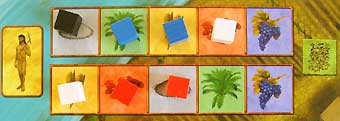 |
| x |
|
|
|
|
|
|
|
|
|
|
|
|
|
|
|
|
|
|
|
|
|
|
|
|
|
|
|
|
|
|
|
|
|
|
|
|
|
|
|
|
|
|
|
|
|
 |
|
With respect to the cards: there are not enough of them to go around. There are only three ‘level 1’ (1 talent income) blue cards, and only players that managed to get one of those are eligible for one of the two ‘level 2’ cards (2 talents income), and only one of those fortunate players can get the ‘level 3’ card (2 talents and 2 points income). And the same goes for the yellow (camel) and pink (victory points) cards. This means that if you’ve had some start-up trouble and you don’t have any level 1-cards, you might not stand any chance at all for the rest of the game. Usually it is not a bad thing if resources or money are tight in a game, but if the consequence is that you have to pass for a couple of rounds and sit idle because there’s absolutely nothing you can do, it’s very frustrating. |
| x |
|
|
|
|
|
|
|
|
|
|
|
|
|
|
|
|
|
|
|
|
|
|
|
|
|
|
|
|
|
|
|
|
|
|
|
|
|
|
|
|
|
|
|
|
|
'Amyitis' is not a game where you can easily plan your actions for several turns in advance. Whether you will succeed to get a peasant, collect the right resource token, manage to move the camel caravan to the desired location and plant the terrace that you had in mind depends of so many factors that you can’t rely on succeeding. The best strategy seems to be to live by the moment and take all the points you can take, and as a result often the winner of 'Amyitis' can’t even explain why exactly he won the game. Despite the fact that it is a nice game to play, this still leaves you with a slightly unsatisfied feeling.
© 2008 Barbara van Vugt
Amyitis, Cyril Demaegd, Ystari / Hutter Trade, 2007 - 2 to 4 players, 12 years and up, 60 to 120 minutes
|
  |
|
|
|
|
|
|
|
|
|
|
|
|
|
|
|
|
|
|
|
|
|
|
|
|
|
|
|
|
|
|
|
|
|
|
|
|
|
|
|
|
|
  |
Unbalanced game with confusing iconography and chaotic design |
  |
|
|
|
|
|
|
|
|
|
|
|
|
|
|
|
|
|
|
|
|
|
|
|
|
|
|
|
|
|
|
|
|
|
|
|
|
|
|
|
|
|
  |
|
|
|
|
|
|
|
|
|
|
|
|
|
|
|
|
|
|
|
|
|
|
|
|
|
|
|
|
|
|
|
|
|
|
|
|
|
|
|
|
|
  |
|
|
|
|
|
|
|
|
|
|
|
|
|
|
|
|
|
|
|
|
|
|
|
|
|
|
|
|
|
|
|
|
|
|
|
|
|
|
|
|
|
  |
Awkward use of colours |
| x |
|
|
|
|
|
|
|
|
|
|
|
|
|
|
|
|
|
|
|
|
|
|
|
|
|
|
|
|
|
|
|
|
|
|
|
|
|
|
|
|
|
|
|
|
|
| x |
|
|
|
|
|
|
|
|
|
|
|
|
|
|
|
|
|
|
|
|
|
|
|
|
|
|
|
|
|
|
|
|
|
|
|
|
|
|
|
|
|
|
|
|
|
 |
|
|
|
|
|
|
|
|
|
|
|
|
|
|
|
|
|
|
|
|
|
|
|
|
|
|
|
|
|
|
|
|
|
|
|
|
|
|
|
|
|
 |
|
|
|
|
|
|
|
|
|
|
|
|
|
|
|
|
|
|
|
|
|
|
|
|
|
|
|
|
|
|
|
|
|
|
|
|
|
|
|
|
|
| x |
|
|
|
|
|
|
|
|
|
|
|
|
|
|
|
|
|
|
|
|
|
|
|
|
|
|
|
|
|
|
|
|
|
|
|
|
|
|
|
|
|
|
|
|
|
 |
|
|
|
|
|
|
|
|
|
|
|
|
|
|
|
|
|
|
|
|
|
|
|
|
|
|
|
|
|
|
|
|
|
 |
|
|
|
|
|
|
|
|
|
|
|
|
|
|
|
|
|
|
|
|
|
|
|
|
|
|
|
|
|
|
|
|
|
|
|